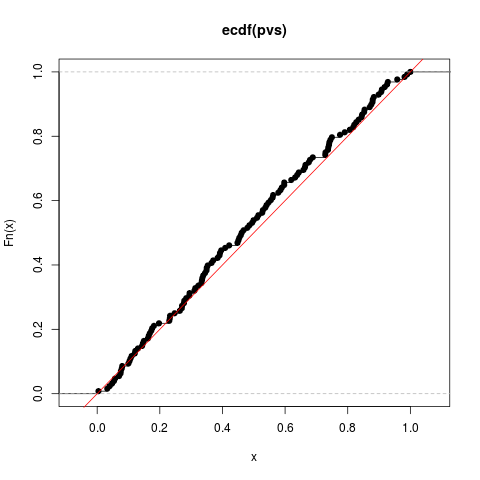Supported by Dr. Osamu Ogasawara and  providing providing  . . |
|
Last data update: 2014.03.03 |
test for Sharpe ratioDescriptionPerforms one and two sample tests of Sharpe ratio on vectors of data. Usage
sr_test(x,y=NULL,alternative=c("two.sided","less","greater"),
zeta=0,ope=1,paired=FALSE,conf.level=0.95)
Arguments
DetailsGiven n observations xi from a normal random variable, with mean mu and standard deviation sigma, tests H0: mu/sigma = S against two or one sided alternatives. Can also perform two sample tests of Sharpe ratio. For paired observations xi and yi, tests H0: mu_x sigma_y = mu_y sigma_x against two or one sided alternative, via
For unpaired (and independent) observations, tests H0: mu_x / sigma_x - mu_y / sigma_y = S against two or one-sided alternatives via the upsilon distribution. ValueA list with class
Author(s)Steven E. Pav shabbychef@gmail.com ReferencesSharpe, William F. "Mutual fund performance." Journal of business (1966): 119-138. http://ideas.repec.org/a/ucp/jnlbus/v39y1965p119.html Pav, Steven. "Inference on the Sharpe ratio via the upsilon distribution.' Arxiv (2015). http://arxiv.org/abs/1505.00829 See Also
Other sr: Examples
# should reject null
x <- sr_test(rnorm(1000,mean=0.5,sd=0.1),zeta=2,ope=1,alternative="greater")
x <- sr_test(rnorm(1000,mean=0.5,sd=0.1),zeta=2,ope=1,alternative="two.sided")
# should not reject null
x <- sr_test(rnorm(1000,mean=0.5,sd=0.1),zeta=2,ope=1,alternative="less")
# test for uniformity
pvs <- replicate(128,{ x <- sr_test(rnorm(1000),ope=253,alternative="two.sided")
x$p.value })
plot(ecdf(pvs))
abline(0,1,col='red')
# testing an object of class sr
asr <- as.sr(rnorm(1000,1 / sqrt(253)),ope=253)
checkit <- sr_test(asr,zeta=0)
Results
R version 3.3.1 (2016-06-21) -- "Bug in Your Hair"
Copyright (C) 2016 The R Foundation for Statistical Computing
Platform: x86_64-pc-linux-gnu (64-bit)
R is free software and comes with ABSOLUTELY NO WARRANTY.
You are welcome to redistribute it under certain conditions.
Type 'license()' or 'licence()' for distribution details.
R is a collaborative project with many contributors.
Type 'contributors()' for more information and
'citation()' on how to cite R or R packages in publications.
Type 'demo()' for some demos, 'help()' for on-line help, or
'help.start()' for an HTML browser interface to help.
Type 'q()' to quit R.
> library(SharpeR)
Attaching package: 'SharpeR'
The following object is masked from 'package:base':
summary
> png(filename="/home/ddbj/snapshot/RGM3/R_CC/result/SharpeR/sr_test.Rd_%03d_medium.png", width=480, height=480)
> ### Name: sr_test
> ### Title: test for Sharpe ratio
> ### Aliases: sr_test
> ### Keywords: htest
>
> ### ** Examples
>
> # should reject null
> x <- sr_test(rnorm(1000,mean=0.5,sd=0.1),zeta=2,ope=1,alternative="greater")
> x <- sr_test(rnorm(1000,mean=0.5,sd=0.1),zeta=2,ope=1,alternative="two.sided")
> # should not reject null
> x <- sr_test(rnorm(1000,mean=0.5,sd=0.1),zeta=2,ope=1,alternative="less")
>
> # test for uniformity
> pvs <- replicate(128,{ x <- sr_test(rnorm(1000),ope=253,alternative="two.sided")
+ x$p.value })
> plot(ecdf(pvs))
> abline(0,1,col='red')
> # testing an object of class sr
> asr <- as.sr(rnorm(1000,1 / sqrt(253)),ope=253)
> checkit <- sr_test(asr,zeta=0)
>
>
>
>
>
>
> dev.off()
null device
1
>
|
